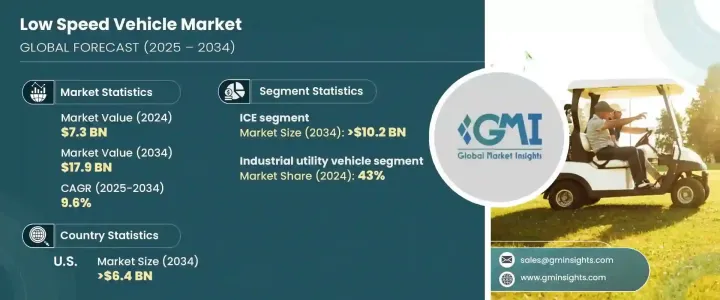
세계의 저속 차량(LSV) 시장은 2024년에 73억 달러로 평가되었으며, 2025년부터 2034년에 걸쳐 CAGR 9.6%로 성장할 것으로 예상됩니다.
도시화가 가속되는 가운데, 도시는 교통 정체, 공해, 과도한 소음 등 과제의 심각화에 직면하고 있습니다. 이 때문에 보다 효율적이고 환경친화적인 교통수단에 대한 수요가 급증하고 있으며, 저속 차량(LSV) 도입이 진행되고 있습니다. 저속 차량은 특히 인구 밀도가 높은 도시 지역과 민간 지역 사회, 상업 공간에서 단거리 이동 솔루션으로 점점 대중화되고 있습니다.

보다 깨끗한 이동성 솔루션이 추진됨에 따라 저속 차량은 지속가능성, 비용 효율성 및 혼잡 지역을 원활하게 이동할 수있는 능력으로 지지를 받고 있습니다. 배터리 기술의 진보에 의해 저속 차량(LSV)의 수명이 연장되고, 충전 시간이 단축되어, 에너지 밀도가 개선되는 등, 저속 차량(LSV)은 보다 효율적인 것이 되어, 개인 및 상업을 불문하고, 보다 매력적인 선택지가 되고 있습니다. 정부의 장려책과 인프라 투자 증가와 함께 전기차의 인기가 높아지고 있는 것이 이 시장의 궤도를 형성하고 있습니다. 또한 지속 가능한 도시 이동성 솔루션을 향한 광범위한 움직임을 반영하여 라스트 마일 배송, 산업 업무 및 시설 내 운송에서 저속 차량의 역할이 계속 확대되고 있습니다.
| 시장 범위 | |
|---|---|
| 시작 연도 | 2024년 |
| 예측 연도 | 2025-2034년 |
| 시작금액 | 73억 달러 |
| 예측 금액 | 179억 달러 |
| CAGR | 9.6% |
추진력 유형을 보면 시장은 내연 엔진(ICE)과 전기 구동의 두 가지 주요 부문으로 나뉩니다. 2024년에는 내연기관을 동력원으로 하는 저속 차량(LSV)가 61% 시장 점유율로 선두에 섰으며 2034년까지 102억 달러를 창출할 것으로 예상됩니다. ICE 자동차의 뿌리 깊은 인기는 저렴한, 신뢰성, 기존 연료 공급 인프라에 기인합니다. 내연 기관차는 일반적으로 비싼 배터리 시스템을 필요로 하지 않기 때문에 전기자동차에 비해 초기 비용이 낮습니다. 게다가, 항속 거리가 길고 연료 보급이 단시간에 가능하기 때문에 끊김 없는 성능을 필요로 하는 유저에게 매력적인 선택지가 됩니다. 내연 기관차를 동력으로 하는 저속 차량(LSV)은 전기 충전 네트워크에 대한 액세스가 제한된 지역에서 특히 선호되며, 원격지 및 개발이 지연된 지역에서도 실행 가능한 옵션으로 계속되고 있습니다.
산업용 유틸리티 차량 카테고리는 저속 차량 시장의 주요 부문이며 2024년에는 43%의 점유율을 차지했습니다. 이러한 차량은 다양한 산업에서 업무 효율성을 높이는 데 매우 중요합니다. 그 컴팩트한 사이즈와 내구성에 의해 엄격한 작업을 해내면서 좁은 스페이스에서도 쉽게 조종할 수 있어, 자재 수송, 시설 관리, 물류에 빠뜨릴 수 없는 것이 되고 있습니다. 기업이 계속 업무를 합리화함에 따라 산업용 유틸리티 차량의 채용이 증가하고 시장에서의 이점을 더욱 높일 것으로 예상됩니다.
미국에서는 저속 차량(LSV)이 우세하며 2024년에는 시장 점유율의 94%를 차지했고 2034년에는 64억 달러에 이를 전망입니다. 이 성장의 원동력이 되고 있는 것은 이 나라의 견고한 인프라와 지속 가능한 모빌리티 솔루션에 대한 수요 증가입니다. 미국에는 레크리에이션과 상용 이용 모두에서 저속 차량(LSV)을 이용하는 문화가 옛부터 뿌리를 내리고 있으며, 이것이 저속 차량(LSV)의 보급을 지원하고 있습니다. 지속가능성에 대한 노력이 계속 지지를 모으는 가운데, 기술의 진보나 소비자의 선호의 진화에 추진되어 시장은 꾸준히 확대할 자세입니다.
The Global Low Speed Vehicle Market was valued at USD 7.3 billion in 2024 and is forecasted to grow at an impressive CAGR of 9.6% from 2025 to 2034. As urbanization continues to accelerate, cities are facing escalating challenges such as traffic congestion, pollution, and excessive noise. This has created an urgent demand for more efficient, eco-friendly transportation options, which is driving the adoption of low-speed vehicles. These vehicles have become an increasingly popular solution for short-distance travel, especially in densely populated urban areas, private communities, and commercial spaces.

With the push for cleaner mobility solutions, low-speed vehicles are gaining traction due to their sustainability, cost-effectiveness, and ability to navigate congested areas seamlessly. As advancements in battery technology make these vehicles more efficient, with longer lifespans, faster charging times, and improved energy density, they are becoming an even more attractive choice for both personal and commercial use. The growing popularity of electric alternatives, alongside government incentives and increasing investments in infrastructure, is shaping the trajectory of this market. Furthermore, the role of low-speed vehicles in last-mile delivery, industrial operations, and intra-facility transport continues to expand, reflecting the broader movement toward sustainable urban mobility solutions.
| Market Scope | |
|---|---|
| Start Year | 2024 |
| Forecast Year | 2025-2034 |
| Start Value | $7.3 Billion |
| Forecast Value | $17.9 Billion |
| CAGR | 9.6% |
When looking at the propulsion types, the market is divided into two key segments: internal combustion engine (ICE) and electric variants. In 2024, internal combustion engine-powered low-speed vehicles took the lead with a 61% market share, and they are expected to generate USD 10.2 billion by 2034. The enduring popularity of ICE variants can be attributed to their affordability, reliability, and the existing infrastructure for fueling. ICE vehicles typically have a lower upfront cost compared to their electric counterparts, as they do not require expensive battery systems. Additionally, their extended range and quick refueling capabilities make them an appealing choice for users who need uninterrupted performance. ICE-powered low-speed vehicles are especially favored in regions with limited access to electric charging networks, ensuring they remain a viable option in remote or less developed areas.
The industrial utility vehicle category is a major segment in the low-speed vehicle market, holding a 43% share in 2024. These vehicles are crucial in enhancing operational efficiency across various industries. Their compact size and durability allow them to maneuver easily through tight spaces while performing demanding tasks, making them indispensable for material transportation, facility management, and logistics. As businesses continue to streamline operations, the adoption of industrial utility vehicles is expected to rise, further driving their dominance in the market.
In the U.S., low-speed vehicles dominate, accounting for 94% of the market share in 2024, with expectations to reach USD 6.4 billion by 2034. This growth is fueled by the country's robust infrastructure and an increasing demand for sustainable mobility solutions. The U.S. has a long-established culture of both recreational and commercial use of low-speed vehicles, which supports their widespread adoption. As sustainability initiatives continue to gain traction, the market is poised for steady expansion, driven by technological advancements and evolving consumer preferences.